|
|
||||||||||||||||||||
 |
|

|
||||||||||||||||||
Star Light, Star Bright What is a galaxy without thousands of stars? A vacuum. Those thousands of stars grouped together form the galaxies you can see with a telescope. Stars are the objects that heat and light the planets in a system. Everything revolves around stars. Thousands of stars cover our galaxy and when you look at our star, the Sun, you will see it is quite small. Throughout the universe, there are big ones, small ones, and different colored ones. We're going to discuss the way scientists study stars and how stars affect the planets that orbit them.
What is a galaxy without thousands of stars? A vacuum. Those thousands of stars grouped together form the galaxies you can see with a telescope. Stars are the objects that heat and light the planets in a system. Everything revolves around stars. Thousands of stars cover our galaxy and when you look at our star, the Sun, you will see it is quite small. Throughout the universe, there are big ones, small ones, and different colored ones. We're going to discuss the way scientists study stars and how stars affect the planets that orbit them.
What Makes a Star?So you're out one night and you look up into the sky. Assuming you aren't in a city with tons of smog or clouds, you will probably see a sky filled with little dots of light. Those dots (this should not be a surprise) are stars. Some are only a few hundred light years away and some are thousands of light years away. They all have some things in common. You see, stars are huge balls of fire. They aren't just any fire. That fire is from a constant number of nuclear reactions.Lighting The WayNot all stars have solar systems spinning around them. Some stars are just sitting out in the middle of nowhere. Some stars have a companion star nearby, kind of like a twin. When you have a twin, astronomers call you a binary star.A star is a huge ball of plasma, usually made of hydrogen (H) and helium (He). That ball of fire also gives off light. All kinds of light. There are visible, infrared, ultraviolet, and X-rays constantly emitted into space. You may find planets that are almost identical to the makeup of stars, like Jupiter, but something has not ignited their nuclear reaction. |

|
|||||||||||||||||||
Useful Reference MaterialsEncyclopedia.com:http://www.encyclopedia.com/topic/star.aspx Wikipedia: http://en.wikipedia.org/wiki/Star Encyclopædia Britannica: http://www.britannica.com/EBchecked/topic/563395/star | ||||||||||||||||||||
|
RETURN TO TOP or Search for more information... * The custom search only looks at Rader's sites. |
|||||||||||||||||||
©copyright 1997-2015 Andrew Rader Studios, All rights reserved. Current Page: Cosmos4Kids.com | Stars | Introduction |
||||||||||||||||||||
|
|
||||||||||||||||||||

